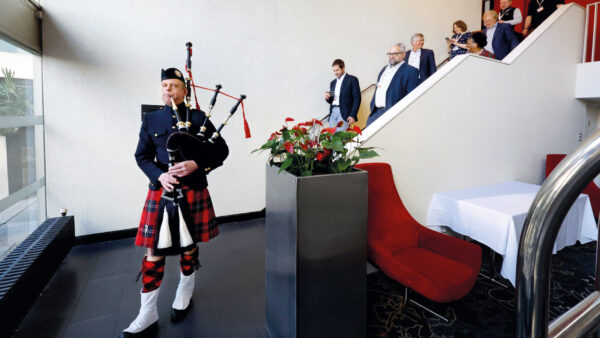
The ‘golden thread’ of information born out of Dame Judith Hackitt’s Grenfell report will soon be a reality. Denise Chevin asks four professionals what this means in practice.
In July, the government published new details setting out expectations for complying with the ‘golden thread’ on projects involving higher-risk residential buildings as part of a raft of consultations to do with implementing the Building Safety Act.
Having a golden thread will mean that those people responsible will have easily accessible, reliable, up-to-date and accurate information, both during design and construction and once the building has been handed over.
Clients and their design and contracting teams have been working within their own organisations to improve data management in preparation for compliance. We talk to four different people representing different parts of the process over the next three pages.
The golden thread requirements will sit alongside those for tighter control procedures, so that if products or designs are changed during construction these are also documented.
Significantly, the golden thread consultation is proposing:
- only relevant information is kept in the golden thread – that is, information supporting compliance with all applicable building regulations; and
- some information will need to be permanently kept and handed over on building completion, while other information may only be needed for a limited period.
Digital information storage
Though the consultation confirms the need to keep information digitally, it deliberately does not specify systems or approach. It says: “We propose to require that the golden thread should be digital and that by digital we mean that information and data is stored electronically and can be transferred electronically. This is a purposefully broad definition.”
The consultation says that the Building Safety Regulator intends to set out some best practice and examples of how someone could implement the golden thread in guidance.
Aman Sharma, managing director of Totus Digital, who is also deputy chair of the Building Regulations Advisory Committee (BRAC) and deputy chair of the BRAC Golden Thread Working Group, says that clients and their teams should not feel the immediate need to buy software claiming to comply with the golden thread.
He says: “My observations are that some parts of industry seem to be trying to capitalise commercially, with the promise of compliance through enterprise software solutions, which is wrong.
“There will be a requirement to keep your golden thread information digitally, and invariably, software will play a part in it. But it’s not the panacea.”
“It’s often the case that the solution is already within the organisation – it just needs some thinking about.”
“And I would implore those dutyholders to resist being enticed into procuring the solution here. It’s often the case that the solution is already within the organisation – it just needs some thinking about.”
He adds: “Dutyholders should ask themselves today: how are we already managing information relevant to building safety, what’s important to us and our residents, what’s golden to us as an organisation and our stakeholders? How can we make this information readily accessible and available in order to demonstrate compliance to the Building Safety Regulator? – who will expect far more than a simple declaration.”
Single point of truth
In terms of digital requirement, the consultation goes on to say: “We propose that the golden thread should operate as a single point of truth so needs to be able to easily shared and therefore interoperable.
“Further, given the length of life of these buildings, it is likely that in the future the golden thread information will need to be transferred to systems that have not been developed.
“For these reasons, we do not want to require particular software and technical solutions which would rapidly become outdated.
“Our approach aligns with the broad requirements of the International Standard ISO 19650 series and the guidance produced by the UK BIM Framework. These standards and guidance define digital information management principles in the built environment and are already used within certain parts of the sector.”
When the information is transferred from the construction team to the accountable person, the transfer plan should set out how they plan to ensure:
- data/information in the golden thread retains its structured format (that is, the information should retain fidelity with its original format – it shouldn’t be changed or lose anything by being transferred); and
- data and/or information remains accessible and any files containing data/information can be opened and are still accessible and useable following transfer.
The client will need to keep the transfer plan updated: “We will work with the Building Safety Regulator to support them in developing guidance. From early discussions, the intention is that it sets out the different types of exchange solution in guidance and not in regulations.”
‘The golden thread in occupation needs to be far simpler than the golden thread in construction’
Mark Snelling, managing director, Armfield Project Management
I’ve had a major involvement in the evolving Building Safety Act and how it will be implemented through my role at The Property Institute, where I’m the health safety and fire advisor. I also play a similar role in the APS as chair of the Legislation and Strategy Committee.
The Act has a robust change control process on projects involving HRBs (higher-risk buildings) to ensure what you build is what is designed, which will be scrutinised at ‘gateways’.
DLUHC (Department for Levelling Up, Housing and Communities) is proposing that all the information the applicant has to submit as part of the building control approval application on these projects, including important changes, should be stored in the golden thread.

“Designers and contractors will need access to the information in the golden thread as long as they are liable for the building – 30 or more years.”
This information is needed by the client, principal designer, principal contractor and relevant dutyholders to ensure they are complying with building regulations and to demonstrate this compliance to the Building Safety Regulator. The requirements to evidence compliance and maintain that evidence will also apply to all building work to which the building regulations apply.
Implementing an assurance process
I implemented an assurance process for a care home company a year and a half ago. I knew what was coming. But it was very difficult to get them to follow this rigid process. But once they’d done it, once they’d bought into it, they thought it was easy and fantastic to know that the fire stopping on a manufacturer’s drawing is what you get on the actual building.
The golden thread in occupation needs to be far simpler than the golden thread in construction. Not all of that information will be needed by the people occupying the building because much of it is a record of the construction process. That is now the approach the DLUHC would appear to be proposing.
But there is a grey box, sitting below the golden thread in occupation, which contains everything else that occupiers don’t need. We’re hoping that a good landlord will keep hold of it, and indeed many of them will. But there’s no legal compulsion to do so.
But designers and contractors will need access to the information in the golden thread as long as they are liable for the building – 30 or more years.
‘Having to develop digital repositories of information is galvanising housing associations’
Chris Lees, founder of consultancy Data Clan and member of the BRAC Golden Thread Working Group
We do not have secondary legislation yet, which will come later this year and add more detail, nor do we have the guidance. But what I’d be saying to principal designers and contractors is be proactive in engaging with the clients.
When BIM was mandated, there was a lot of information handed over to clients which they couldn’t use. So, I would encourage designers and contractors to get joined up with the clients. I would advocate the use of industry standards (the consultation gives information management ISO 19650 for example).

“What I’d be saying to principal designers and contractors is be proactive with your clients.”
In the longer term, I can see that the asset manager and the client are going to be the one that will essentially own and operate their common data environment across all of their projects.
Desire for better data
The demands of the Building Safety Act for a golden thread of information, and housing providers’ own desire to ensure safety of residents in the aftermath of Grenfell, is driving the desire to use data better. I’m working with a number of housing associations and the need to develop digital repositories of information about their housing stock is having a galvanising effect on them.
It has encouraged the more forward-thinking to explore how sharing data across asset management, housing management and development can benefit their residents while also streamlining their operations.
People have started to say, instead of thinking about housing management and assets, let’s really think about the customer – and that spans both, because one of the things that any housing provider will tell you is, if you’re looking at customer satisfaction, the number one problem that customers will report is repairs.
And so, when you start taking a customer view, that starts to bring together the asset world and the housing management.
‘Consultancies like ours could potentially take on a bigger role’
Mike Stowell, director Acaster Safety Management
The new approach takes me back quite a few years in terms of providing full compliance and providing evidence for building regulations.
I worked in Ireland for about four years as a project architect and I was responsible for compliance with building regulations (apart from Part B for fire, which was the fire service) which involved producing a building log which ticked off every single regulation and how the building complied with it.

“There’s a big crossover between health and safety and building control.”
What is being proposed in the Building Safety Act will be more involved, in terms of providing evidence for compliance with the building regs. And I think that will be a huge challenge providing that level of documentation. Consultancies like ours which take on the principal designer role for CDM could potentially be looking at taking on a bigger role acting as the principal designer for the building regulations.
Health and safety crossover
There’s a big crossover between health and safety and building control, because you can’t do one without having some knowledge and understanding of the other. So it is conceivable that the principal designer CDM and the principal designer building control could be the same organisation or individual, providing the appropriate competencies are available.
I know that there are mixed views on whether individuals and organisations think they have the relevant competencies to actually complete those tasks. There will be an element of retraining required for those that want to spread from CDM into compliance with building regulations – and they will need to demonstrate that competence.
We’ve been advising clients that there is going to be a change and it will take some time to implement it, but there are steps they can start taking now. Some clients struggle with that a bit, because they don’t want to spend money now before they need to.
One of the challenges will be how the information produced to comply with the golden thread is stored. It would be great if there was a way of depositing that information so it can be accessed at a later point by any relevant person.
‘We’re exploring a range of options to help staff navigate relevant data’
Margaret Sackey, capital projects health and safety manager, University College London
In my role I help support capital projects health and safety management arrangements and also support all estates projects more widely. The capital projects team has on-going projects from large capital to minor works including developments on the new UCL East Campus on the Olympic Park in Stratford.
I make sure that UCL employer’s requirements with regards to projects health and safety are upheld – not just in terms of the information, but the performance and culture.
Building information including the health and safety file is provided as a single PDF at handover with hyperlinks into the operating and maintenance manual. But we want to move towards a more collaborative and intuitive format. And there are plans for improving our building information management employer’s information requirements and arrangements.

“We’re exploring different options including setting up a front portal that will help staff navigate relevant data.”
It’s not just about having a model, it’s about the structure and collation of information. And that’s the change of culture we’re seeking to introduce. We amended our employer’s requirements earlier this year to reflect that.
We have a lot of digital information we have gathered for many years and that needs to be available in more structured format and for people to be able to find information quickly.
Fire safety standards
The Fire Safety Team has done a great deal in this area to an agreed fire safety standard and we’re seeking to almost piggyback on to that to ensure that we comply with the Building Safety Act when it comes into force.
We are gearing up for the golden thread – including additional appointments for ensuring compliance with competence requirements, which will be inculcated into our UCL project and operational procedures.
There is a clear overlap between CDM under the Health and Safety at Work Act and building safety legislation under the new Building Safety Act.
We use many different information systems at UCL and so we’re exploring different options including setting up a front portal that will help staff navigate relevant data. We have a Building a Safer Future Working Group at UCL which will recommend the most suitable solution.












